Converting pastures to native warm season grasses: Summer forage and wildlife habitat in Caroline County
ID
SPES-308NP
Introduction
While warm season annual grasses can produce large amounts of high-quality forage in the summertime, this forage often comes at significant financial cost. In addition to the yearly costs of seed, fertilizer, equipment, and labor, establishing annuals can be a risky endeavor with the possibility of summer droughts.
Native warm season grasses (NWSG) also may be utilized to produce large amounts of high-quality forage in the summertime, but perennial species don’t require annual establishment costs or risks. These species are well adapted to Virginia, and don’t require as much inputs as intensively managed annual species that have been cultivated and introduced from other areas of the world.
Other advantages of NWSG species include providing habitat for wildlife and diversity in the forage base.
Unfortunately, historic challenges with establishment and misperceptions surrounding nutritional quality and stand management largely account for farmer reluctance to convert tall fescue (Schedonorus arundinaceus) pastures to NWSG in Virginia. We intend to address these issues through demonstrations: this fact sheet will provide documentation of a producer’s real-world conversion experience.
Swallow Hill Farm, Woodford, VA
Tim and Sue Tobin raise forage fed and finished beef for their community, along with a number of other farm-raised products such as eggs, pork, lamb, and honey. The farm is strategically located between large population centers in Richmond and Northern Virginia.

A priority for the Tobins has been to improve the quality of their land and farm resources, which in turn improves conditions for the entire ecosystem around them and downstream from them. In particular, with family living on the Chesapeake Bay, the Tobins understand the importance of management intensive grazing and keeping livestock out of surface waters. Tim Tobin was named the 2021 Forage Producer of the Year by the Virginia Forage and Grassland Council in recognition of his achievements and contributions to his community.
Swallow Hill Farm beef is highly sought after, and Tim credits the quality of their product to intensive forage production. Tim utilizes annual forages in both the summer and winter for finishing animals, and he has converted existing tall fescue pastures to novel endophyte tall fescue while also interseeding diverse legumes into other fields that have not yet been renovated.
Tim recognizes that a key to their farm’s profitability lies in extending the grazing season. However, establishing forages on an annual basis requires significant inputs. For this reason, Tim decided to integrate NWSG into his pasture system.
Tim selected the 8-acre conversion site for two reasons. First, he had already slated these fields for renovation due to a need to eradicate nimblewill (Muhlenbergia schreberi). Second, he wanted to provide wildlife habitat in these perimeter fields as a sort of wildlife corridor to neighboring woodlands.
Tim summed up his reason for converting to NWSG: “If all goes well with this planting, we will be able to support native wildlife while producing high quality forage for our livestock.”
Conversion Process
The process that Tim utilized to renovate a tall fescue pasture with a nimblewill infestation to Eastern gamagrass (Tripsacum dactyloides cv. Pete) involved four rotations of annual forages over two years to ensure that the weeds were sufficiently controlled.
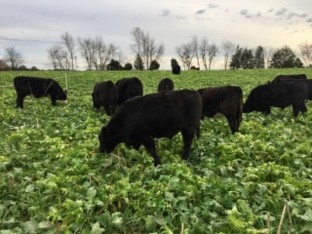
| Category | Task | Date |
|---|---|---|
| Seed bed preparation | Spray cool season grasses | May 12, 2017 |
| Seed bed preparation | Establish smother crop | May 15, 2017 |
| Seed bed preparation | Harvest smother crop | July-August, 2017 |
| Seed bed preparation | Spray smother crop | September 6, 2017 |
| Seed bed preparation | Establish smother crop | September 11, 2017 |
| Seed bed preparation | Harvest smother crop | April-May, 2018 |
| Seed bed preparation | Spray smother crop | May 27, 2018 |
| Seed bed preparation | Establish smother crop | May 30, 2018 |
| Seed bed preparation | Spray smother crop | September 18, 2018 |
| Seed bed preparation | Establish smother crop | September 20, 2018 |
| Establishment | Plant NWSG (10 lb. of Pure Live Seed/ac) | December 18, 2018 |
| Establishment | Graze smother crop | March, 2019 |
| Establishment | Spray smother crop | March 19, 2019 |
| Establishment | Evaluate stand | Summer, 2019 |
| Establishment | Clip field | August 4, 2019 |
| Establishment | Burn stand | April 4, 2020 |
| Utilization: Year 1 | Rest field | 2019 until early June, 2020 |
| Utilization: Year 1 | Rotationally stocked lightly with cattle | June 10-18 July 26-31 Sept 27-Oct 3 |
Tim’s choice of annual forages included German millet (Setaria italica) and cow peas (Vigna unguiculata) in the first summer and diverse mixtures of seasonally appropriate annual forages in the first winter and second summer.
Tim also established the gamagrass in December to induce germination through the natural cold stratification process. Tim drilled the seed directly into a fall-planted stand of spring oats (Avena sativa), along with 100 lb/acre of pelletized lime as a carrier. The soil test recommended no additional fertilizer for the establishment of the gamagrass.
Cattle grazed the oat forage once in February to remove some of the residual biomass. Tim then sprayed the oats prior to any germination of the NWSG. This spray took place in March, but Tim believes it was slightly early as it was still cool. Warmer temperatures likely would have resulted in a better kill of the weeds.
Germination and weeds
The planting was evaluated in the summer of 2019, and unfortunately, a tremendous amount of crabgrass (Digitaria spp.) and foxtail (Setaria spp.) had germinated in the field.
It was difficult to identify the gamagrass seedlings due to the heavy competition from crabgrass and foxtail. He was initially very concerned that the weed load would cause a stand failure, but he later found much of the gamagrass had germinated.
Tim decided to clip the pasture at a 12” height to set back the crabgrass & foxtail and to open the canopy for the young gamagrass seedlings.
The following spring, Tim burned the stand to reduce weed competition and surface residue and to release nutrients for the developing gamagrass. Before long, the gamagrass started emerging through the ash.
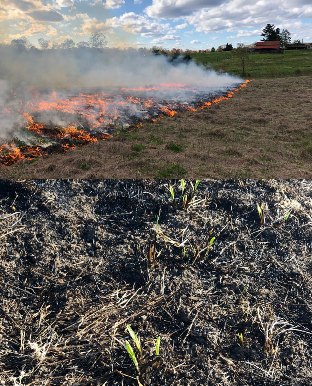
Utilization
The gamagrass regrew very fast in the second growing season, enabling three light grazings.
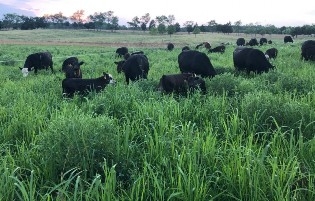
Tim strip-grazed the pasture three times that summer with the breeding herd (21 cows, 20 spring calves, and a bull), with fresh forage allocated daily.
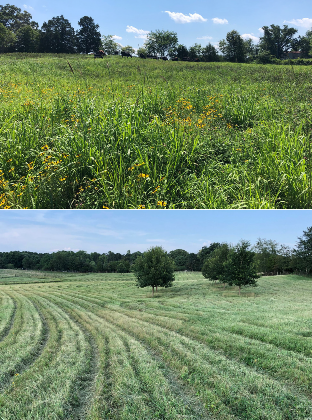
Once the first frost sent the gamagrass into dormancy, Tim turned in a flock of 20 sheep to graze the residue and clover.
Maybe it’s a coincidence, but quail have already been heard in this gamagrass pasture, and Tim has video proof to show it.
Next steps
On June 24, 2020, Tim also planted a pasture with a mixture of big bluestem (Andropogon gerardii), little bluestem (Schizachyrium scoparium), and indiangrass (Sorghastrum nutans).
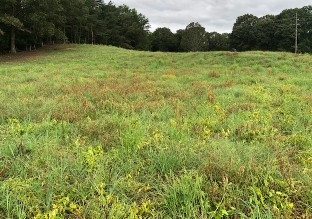
Tim is looking forward to seeing how that forage performs in the summer of 2021. He believes the addition of the NWSG will help to fill a summer niche and reduce the risks and costs of planting summer annuals.
Acknowledgements
Thanks to Tim Tobin and Swallow Hill Farm for providing information on their experience converting a pasture to NWSG.
This fact sheet has been developed as part of a project funded in part by a USDA-NRCS Conservation Innovation Grant.
Commercial products and/or services are named in this publication for information purposes only. Virginia Cooperative Extension, Virginia Tech, and Virginia State University do not endorse or warrant these products and/or services, and they do not intend or imply discrimination against other products and/or services that also may be suitable.
Virginia Cooperative Extension materials are available for public use, reprint, or citation without further permission, provided the use includes credit to the author and to Virginia Cooperative Extension, Virginia Tech, and Virginia State University.
Virginia Cooperative Extension is a partnership of Virginia Tech, Virginia State University, the U.S. Department of Agriculture (USDA), and local governments, and is an equal opportunity employer. For the full non-discrimination statement, please visit ext.vt.edu/accessibility.
Publication Date
March 5, 2021



